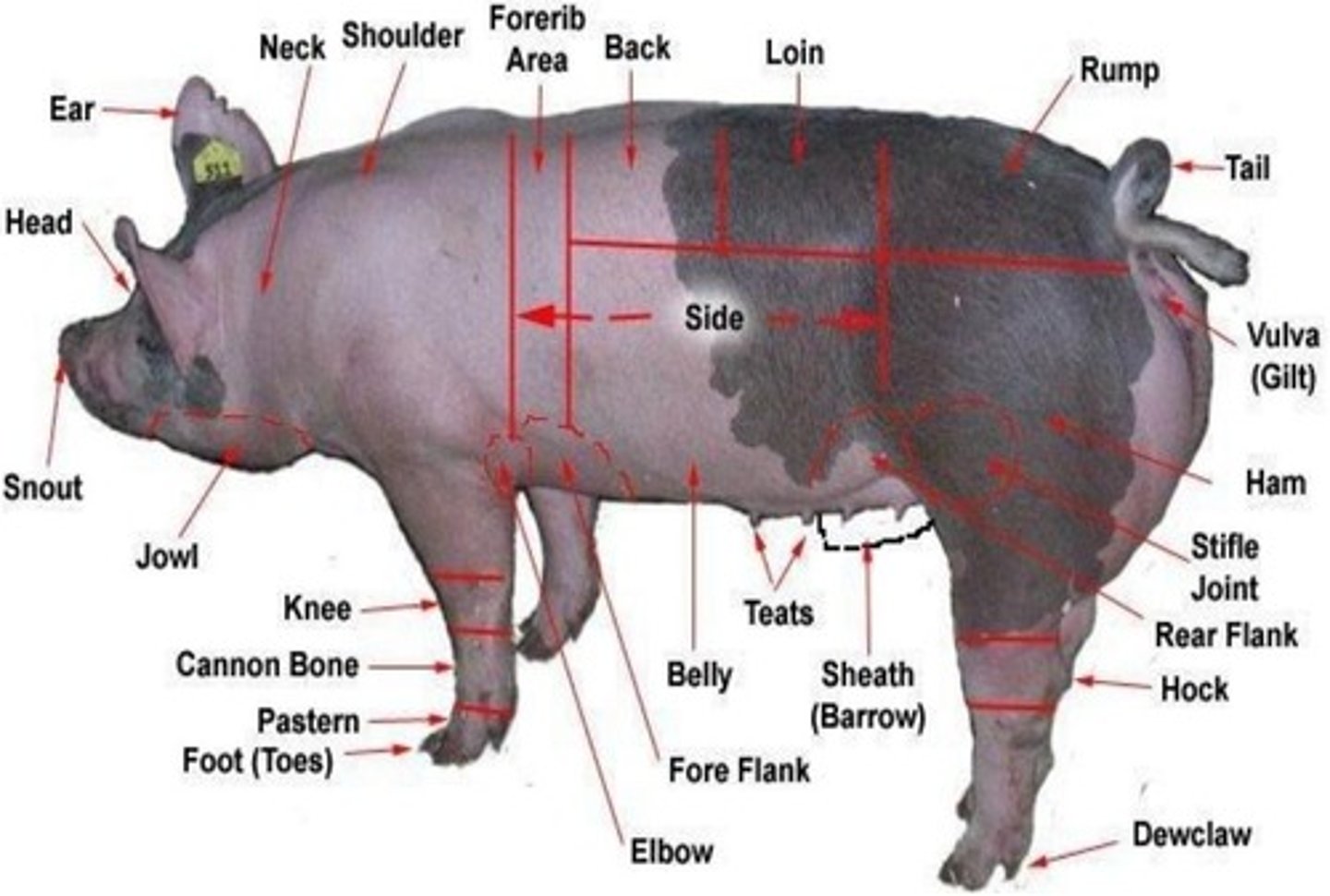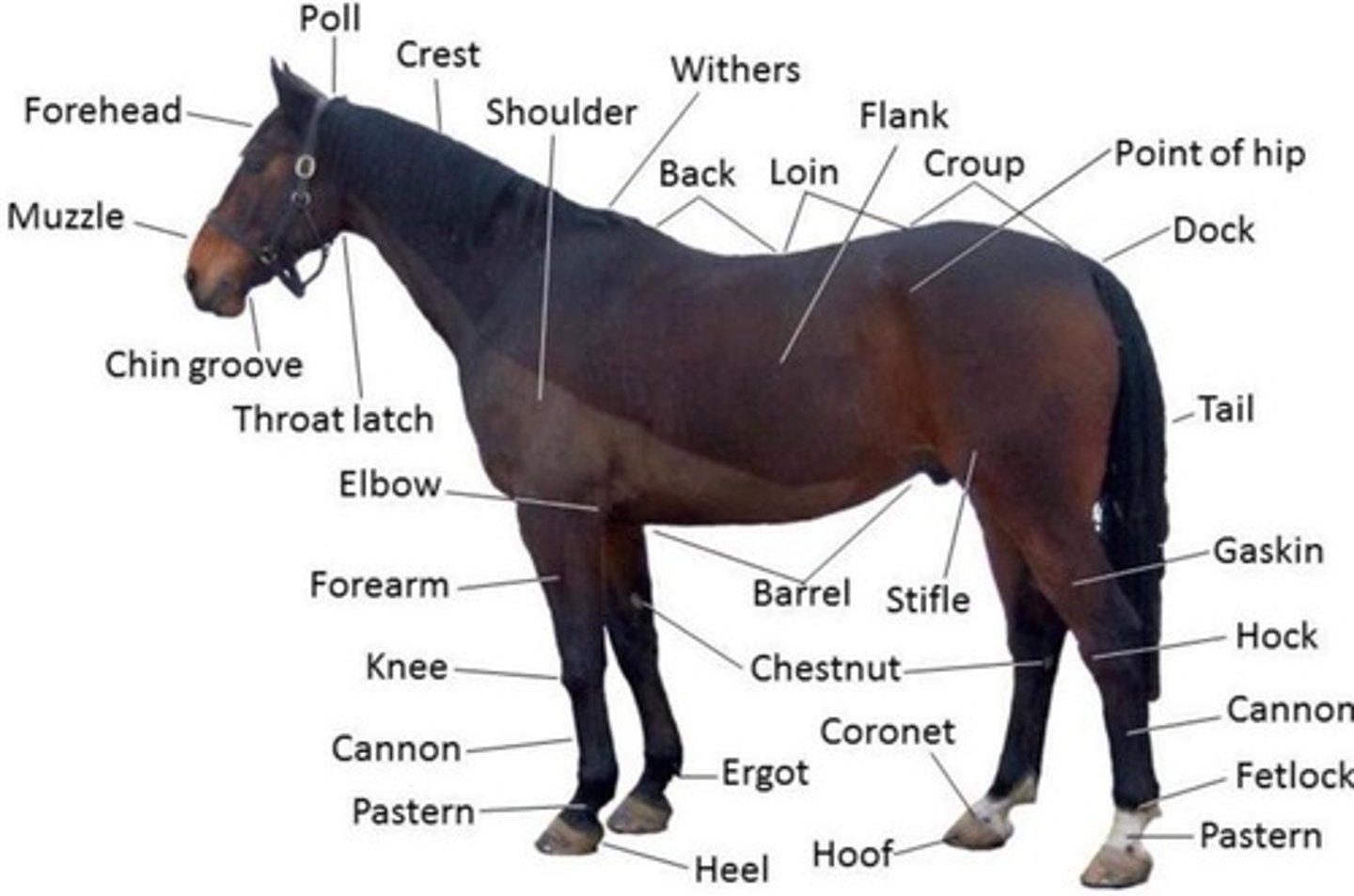External Anatomy of Cows, Pigs, Chickens, Horses, and Sheep
1/78
There's no tags or description
Looks like no tags are added yet.
Name | Mastery | Learn | Test | Matching | Spaced |
|---|
No study sessions yet.
79 Terms
Loin
The part of the body lying on each side of the spinal column between the hip bone and last rib.
Rump
Region of sacrum, point of rump is the highest point formed by the sacral tuber.
Hoof
The outer horny covering of the foot, which is divided into two parts called claws.
Dew claws
Two horny callosities behind the fetlock joint.
Pastern
The region below fetlock and above coronet.
Body
Comprises the chest, belly and flank.
Hock
The complex joint formed between lower thigh and cannon.
Poll
Located above and between the ears.
Forehead
From the poll down to the level of the eyes.
Face
From the level of the eyes downward to the nostrils.
Bridge of nose
Area of nasal bone.
Nostrils
Two natural openings for breathing.
Stifle
The first joint below the hips on the hind leg.
Dewlap
Beneath the lower jaw or neck.
Muzzle
Above the upper lip.
Tail head
Where the tail joins the rump.
Cannon
The portion between the knee joint and fetlock joint.
Coffin
Bottommost bone in the front and rear legs.
Elbow
Found where its leg meets with the torso.
Rear flank
Located just below the loin.
Fore flank
Located the front portion of the ribs.
Fetlock
Joint above the pastern.
Brisket
It comes from the breast/pectoral area.
Male reproductive system
Sheath (prepuce) - flap of skin in the abdominal region.
Female reproductive system
Naval flap - loose skin below the abdomen.
Udder
Mammary gland.
Teats
Where milk is drawn.
Milk well
Where the milk vein enters into the abdominal wall.
Milk vein
A large vein visible under the skin on the belly of the cow. It passes along the abdominal wall.
Forearm
The forearm is located above the knee and is the thickest part of the front leg before entering the chest.
Fore Flank/Fore Rib
The fore flank or fore rib is located on the front portion of the ribs. This portion of the chest cavity should be one of the widest parts of the pig's chest.

Belly / Ribs
The belly and ribs are located just behind the shoulders and elbow pocket.
Knee
The knee is located just above the dewclaws and just below the elbow pocket.
Underline
The underline is the collection of teats where a litter of pigs will nurse their mother.
Dewclaws (Pig)
The dewclaws are the smaller appendages on the back of the pig's legs, located above the hooves.
Pasterns (Pig)
The pasterns are located just below the dewclaws and above the pig's hooves.
Neck
The neck is located just behind the ears and in front of the shoulder.
Ears
The ears are located just above the eyes and in front of the neck.
Eyes
The eyes are located on the face and below the ears.
Snout (Nose)
The snout of the pig is located by the mouth.
Jowl
The jowl is located underneath the snout and is sometimes referred to as the pig's chin.
Elbow Pocket
The elbow pocket is located above the forearm and behind the shoulder.
Stifle Muscle
The stifle muscle is the muscle used to move the pig's rear legs.
Ham
The ham is the cut of meat located below the tail and above the hocks.
Tail
The size and placement of the tail can vary from breed to breed and pig to pig.
Ham Loin Junction
The ham loin junction is the place where the ham and loin come together.
Shoulder
The shoulder is located behind the neck and in front of the ribs.

Chine Bone
This is the bone located between the shoulder blades of the pig.
Hackle
Feathers around the neck. Hackle feathers are raised when they feel threatened or want to intimidate a fellow chicken.
Wattle
Two fleshy coloured, featherless fleshy folds of skin hanging below the beak. This also helps to cool birds down.
Cape
Narrow feathers between a chicken's neck and back. It is primarily for display and also serves to cool the bird down.
Back
The area of the thoracic vertebrae.
Saddle
The part behind the back reaching up to the tail.
Main Tail Feathers
They are the feathers located at the posterior or caudal part, and they point upwards. Used for balance and flying.
Sickle Feather
In a rooster's tail and is the main long feather in the tail.
Spur
Bony protuberance on the inside of the cock's shank, not developed in female fowl. It is an effective weapon for protecting a flock from predators.
Claw
Also known as a talon, projects backward from the ankle. It is used for scratching.
Comb
It is the fleshy attachment on the top part of the chicken's head, and it is usually red. This serves as a cooling system.
Toes
Each foot has four toes, three toes point forward while one points backward for balancing purposes.
Gaskin
The large muscle in the hind leg, just above the hock and below the stifle.
Girth
The area right behind the elbow of the horse.
Point of Hip
The bony protrusion above the flank and below the croup.
Barrel
The body of the horse, enclosing major organs and the rib cage.
Cannon/Cannon Bone
The area between the knee and or hock and the fetlock joint, also commonly known as the "shin" of the horse, when in reality it is the third metacarpal.
Chestnut
A callosity on the inside of each of the horse's legs.
Chin Groove
An area that dips down slightly on the lower jaw, behind the lower lip and chin.
Flank
Where the hind legs and barrel meet - specifically the area right behind.
Throat latch
The point at which the windpipe meets the head at the underside of the jaw.
Withers
The highest point of the thoracic vertebrae, just above the tops of the shoulder blades.
Heel
Back side of the hoof.
Mare (Female)
Females are usually shorter than males of the same breed. Have thinner necks compared to males. Female genitals (Vagina, Vulva etc.) Two mammary glands & Two Teats.
Stallion (Male)
Taller than mares. Male Genitals (Penis, Testes etc.) Thicker necks than females.
Foreshank
The front part of the shoulder as well as part of the leg.
Dewclaw
Gives them the ability to climb on rocks with a secure foothold.
Hock (Sheep)
The joint between the tarsal bones and tibia.
Tail (Sheep)
To protect the sheep's anus, vulva, and udder.

Hip Bone
The cartilage of this is transformed into a flexible ligament late in pregnancy.
Ewe
Female sheep often have horns as well. Female sheep also have two teats.
Breast
Provides the nourishment of the young.